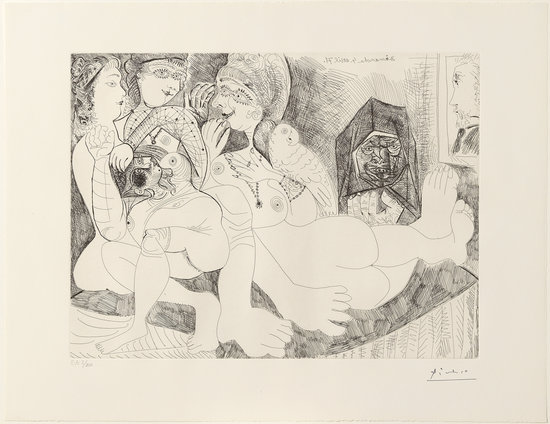The Picasso Museum displays ‘The 156 engravings’
The exhibition can be visited from the 26th of May until the 4th of September. It displays artworks created by Picasso between the 24th of October 1968 and the 25th of March 1972, and first shown in Paris only a year after their completion in 1973, when the artist was still alive. “The last Picasso, the engraver”, is shown in this exhibition, one who “experimented freely” and had an “overflowing life force”, according to a statement released by the museum. The artist created these works at his home in France, and in them, he focuses on the same subjects he always used, such as the painter and the model, and focuses especially on the female nude. Picasso also pays homage to several other artists in the series, including Goya, Manet, Raphael, Rembrandt, Velázquez, and especially Degas. The Museum calls the collection a “final tragicomedy, rich and complex”.

Barcelona (CNA).- ‘The 156 engravings’ exhibition will be on display at the Picasso Museum, and will be open from the 26th of May until the 4th of September. The exhibition showcases pieces done by the artist between the 24th of October 1968 and the 25th of March 1972, and was first shown in Paris in 1973, when Picasso was still alive. Here, we see “the last Picasso, the engraver”, according to the eponymous museum, which speaks of how Picasso “experimented freely” in this last stage of his life, and who had an “overflowing life force”. The artist created these works in his home in France, using the subjects he had always used, such as the painter and the model, focusing in particular on the female nude. The artist from Malaga also pays homage to several other artists in the series, including Goya, Manet, Raphael, Rembrandt, Velázquez, and especially Degas. This collection is, according to the Picasso Museum, a “final tragicomedy, rich and complex, in which the artist reflects on love, life and art”.
The Picasso Museum is hosting the exhibition ‘The 156 engravings’, a collection of works by the Málaga artist created between the 24th of October 1968 and the 25th of March 1972. Open from the 26th of May until the 4th of September, the exhibition became part of the collection of the museum centre thanks to a donation made by Pablo Ruiz Picasso’s heirs in 1980. The donation was made through the ‘Galerie Louise Leiris’ in Paris, where the works were first exhibited in 1973, when the artist was still alive. According to a statement from the Picasso Museum, the exhibition “represents the last Picasso, the engraver, one who experimented freely with techniques and with an overflowing life force”. The collection consists of fifty prints, numbered from 1 to 50, along with fifteen artist proofs numbered with Roman numerals and three printed preliminary studies identified by the letters A, B and C.
The works of the exhibition ‘The 156 engravings’ were made at Picasso’s home in Notre-Dame-de-Vie in the French town of Mougins, during the last stage of his life when he returned to engraving and metal engraving. During this period, he worked with two printers, the brothers Piero and Aldo Crommelynck. With these works Picasso takes liberty with experimentation techniques, and, according to the Picasso Museum, “achieves particular tones through, for example, aquatint which he later touched up with drypoint, burnishing, or etching techniques, which acts as a unifying element of the whole”.
“An erotic world in which voyeurism is just beneath the surface”
Picasso “shows a (certain) security and virtuosity in his strokes which are unusual”, and the artist summarises “many of the subjects he always used, like that of the painter and that of the model”; in fact, “the female nude is the star”. “The entirety is an erotic world in which voyeurism is just beneath the surface”, stated the museum in a statement regarding the exhibition dedicated to Picasso.
The engravings in this exhibition also make artistic reference to Goya, Manet, Raphael, Rembrandt, Velázquez, and especially Degas, who appears in 38 scenes. In fact, according to the Picasso Museum, the 156 pieces are a “final tragicomedy, rich and complex, in which the artist reflects on love, life and art”.